Incorporating Other Reference Tables
|
| < Day Day Up > |
|
TOCs aren't the only reference tables you'll use as you work with long documents. If you use illustrations, tables, diagrams, or equations, you'll like having the choice of numbering and labeling those elements automatically. If you work with legal briefings and citations, the ability to create a table of authorities will save you considerable time and trouble.
Building a Table of Figures
When you have Word generate a table of figures to use as a reference tool in your document, Word searches for and collects the figure captions in your document. This means that you need to set up your captions before you generate the table.
Adding Captions
First things first. Start by adding labels to the items you want to include in your table of figures. You can add captions while you work by using Word's AutoCaption feature. Here are the steps to follow:
-
Choose Insert, Reference, Caption. The Caption dialog box appears.
-
Click AutoCaption. The AutoCaption dialog box, shown in Figure 21-7, appears.
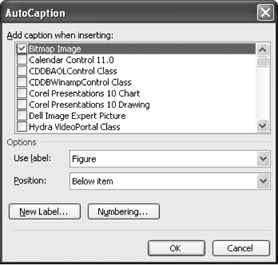
Figure 21-7: AutoCaption enables you to add labels and numbers to your figures automatically. -
In the Add Caption When Inserting box, select the check boxes next to the elements for which you want to add captions.
-
In the Options section, choose the label you want to use, click the Position arrow, and then select Above Item or Below Item.
-
Click OK to have Word search for and update the elements in your document.
Note To view and work with the various options available for your table of figures, choose Insert, Reference, Index And Tables, and then click the Table Of Figures tab.
Controlling Figure Numbering
If you want to add figure numbering to your captions, choose Insert, Reference, Caption to display the Caption dialog box. Select the element to which you want to add the numbering (or update your other caption choices), and then click Numbering. The Caption Numbering dialog box appears, as shown in Figure 21-8.
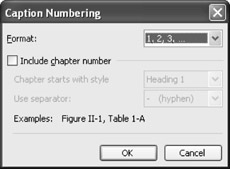
Figure 21-8: The Caption Numbering dialog box enables you to choose the format and style of the numbering sequence.
Begin by choosing the format you want to use for the numbering sequence. You can choose the traditional 1, 2, 3 or A, B, C, or you can choose roman numerals for figure numbering in the Format list box. If you want to include chapter numbers (which Word picks up from the text), select the Include Chapter Number check box. Next, specify the first heading style in the chapter (this shows Word where to begin looking), and then select a separator character from the Use Separator list box (Word will place this between the chapter number and the figure number in the caption). Click OK to save the settings. When you add your next figure, the caption will be applied automatically.
Generating a Table of Figures
After you've added captions to your illustrations by choosing Insert, Reference, Caption, you can use those captions to create a table of the figures in your document. Follow these steps to generate a table of figures:
-
Place the insertion point where you want to create the table of figures.
-
Click Insert, Reference, Index And Tables. The Index And Tables dialog box appears.
-
Click the Table Of Figures tab. The default selections for the table are displayed in the preview boxes, as shown in Figure 21-9.
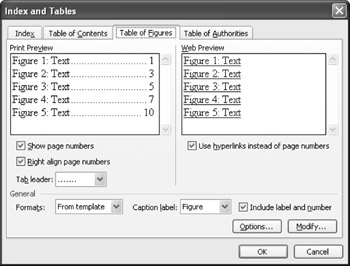
Figure 21-9: The preview boxes in the Index and Tables dialog box show the default selections. -
Change the settings as needed, and then click OK to create the table. The table of figures is placed in the document at the insertion point.
Building a Table of Authorities
A table of authorities is a more specialized table reference that helps you track, compile, and display citations in your document. You'll use this feature most often for legal documents that reference cases, rules, treaties, and other documents. Before you can create a table of citations, obviously, you need to have placed those citations within the body of the document.
Adding Citations Manually
You can easily track citations for inclusion in the table of authorities as you work in your document. To begin the process of adding a citation, follow these steps:
-
Select the citation in the document.
-
Press Alt+Shift+I. The Mark Citation dialog box appears with the selected citation displayed in the Selected Text box, as shown in Figure 21-10.
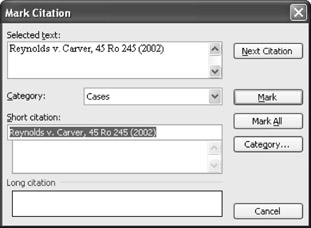
Figure 21-10: Use the Mark Citation dialog box to include citations in your table of authorities. -
Click the Category arrow, and then choose the type of citation you're creating.
-
Edit the citation, if needed, in the Short Citation box.
-
Click Mark. Word adds the necessary codes to your document to identify the citation for inclusion in the table of authorities.
-
In your document, select another citation, and then click in the Selected Text box. This adds the citation to the box. Again, click Mark to add the citation.
-
Click Close to close the dialog box when you're finished adding citations.
Tip Add citations directly You can also add citations from the Table Of Authorities tab in the Index And Tables dialog box. To display the tab, choose Insert, Reference, Index And Tables, and then click the Table Of Authorities tab. Click Mark Citation to display the Mark Citation dialog box. Enter your citation as needed, and then click Mark to complete the entry.
Generating the Table of Authorities
After you've entered the citations you want to reference, you can start the process of creating a table of authorities by following these steps:
-
Click Insert, References, Index And Tables.
-
Click the Table Of Authorities tab to choose the settings for the table of authorities you create, as shown in Figure 21-11.
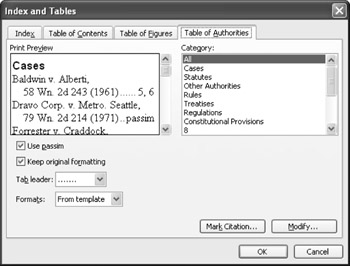
Figure 21-11: The Table Of Authorities tab includes everything you need for entering and formatting the table. -
Choose your category from the list on the right.
-
Choose the formatting and styles you want, and then click OK to create the table of authorities.
Note If you've created multiple tables in your document, be sure to update each table independently. To update, click in the table, and then press F9.
|
| < Day Day Up > |
|
EAN: 2147483647
Pages: 373